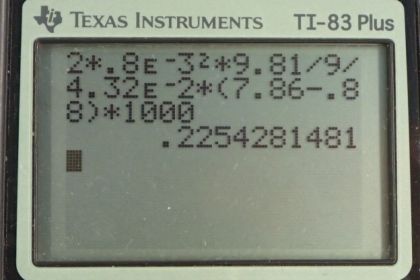Question
Using the equation of the previous problem, find the viscosity of motor oil in which a steel ball of radius 0.8 mm falls with a terminal speed of 4.32 cm/s. The densities of the ball and the oil are 7.86 and 0.88 g/mL, respectively.
Final Answer
Solution video
OpenStax College Physics for AP® Courses, Chapter 12, Problem 39 (Problems & Exercises)

vote with a rating of
votes with an average rating of
.
Calculator Screenshots
Video Transcript
This is College Physics Answers with Shaun Dychko. This formula tells us the terminal velocity of a spherical thing falling through a fluid. We're given the density of the sphere which is the density of steel, and then minus the density of the liquid that it's flowing through. We have the radius r of the sphere, and this is gravitational field strength g, and this is the viscosity of the fluid. Now our job in this question is to figure out what is the viscosity. So we multiply both sides by nu over v and we solve for nu. So viscosity is two times radius squared g over nine times speed, terminal speed, times the difference in densities. So we have two times 0.8 times ten to the minus three meters squared, times 9.81 meters per second squared, divided by nine times the viscosity which is -- sorry, the terminal velocity I should say, 4.32 times ten to the minus two meters per second and then times by the difference in densities. This difference will have units of grams per milliliter and then we'll convert that grams per milliliter into kilograms per cubic meter by multiplying by one kilogram for every one thousand grams, and then times by a thousand milliliters for every liter, so we get liters on the bottom, and then times by a thousand liters squared cubic meter, so we end up with cubic meters in the denominator. This works out to 0.225 pascal seconds is the viscosity of this oil.
